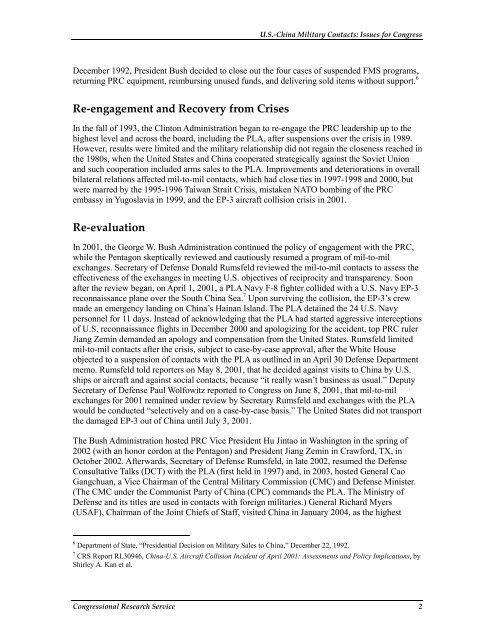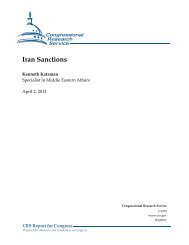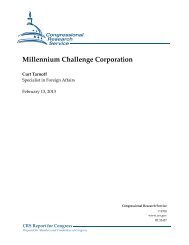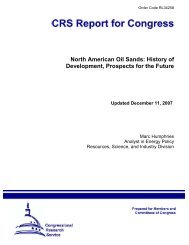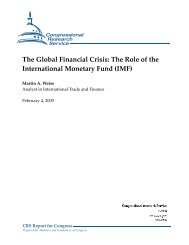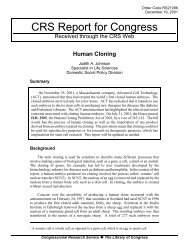U.S.-China Military Contacts: Issues for Congress - Foreign Press ...
U.S.-China Military Contacts: Issues for Congress - Foreign Press ...
U.S.-China Military Contacts: Issues for Congress - Foreign Press ...
You also want an ePaper? Increase the reach of your titles
YUMPU automatically turns print PDFs into web optimized ePapers that Google loves.
U.S.-<strong>China</strong> <strong>Military</strong> <strong>Contacts</strong>: <strong>Issues</strong> <strong>for</strong> <strong>Congress</strong><br />
December 1992, President Bush decided to close out the four cases of suspended FMS programs,<br />
returning PRC equipment, reimbursing unused funds, and delivering sold items without support. 6<br />
Re-engagement and Recovery from Crises<br />
In the fall of 1993, the Clinton Administration began to re-engage the PRC leadership up to the<br />
highest level and across the board, including the PLA, after suspensions over the crisis in 1989.<br />
However, results were limited and the military relationship did not regain the closeness reached in<br />
the 1980s, when the United States and <strong>China</strong> cooperated strategically against the Soviet Union<br />
and such cooperation included arms sales to the PLA. Improvements and deteriorations in overall<br />
bilateral relations affected mil-to-mil contacts, which had close ties in 1997-1998 and 2000, but<br />
were marred by the 1995-1996 Taiwan Strait Crisis, mistaken NATO bombing of the PRC<br />
embassy in Yugoslavia in 1999, and the EP-3 aircraft collision crisis in 2001.<br />
Re-evaluation<br />
In 2001, the George W. Bush Administration continued the policy of engagement with the PRC,<br />
while the Pentagon skeptically reviewed and cautiously resumed a program of mil-to-mil<br />
exchanges. Secretary of Defense Donald Rumsfeld reviewed the mil-to-mil contacts to assess the<br />
effectiveness of the exchanges in meeting U.S. objectives of reciprocity and transparency. Soon<br />
after the review began, on April 1, 2001, a PLA Navy F-8 fighter collided with a U.S. Navy EP-3<br />
reconnaissance plane over the South <strong>China</strong> Sea. 7 Upon surviving the collision, the EP-3’s crew<br />
made an emergency landing on <strong>China</strong>’s Hainan Island. The PLA detained the 24 U.S. Navy<br />
personnel <strong>for</strong> 11 days. Instead of acknowledging that the PLA had started aggressive interceptions<br />
of U.S. reconnaissance flights in December 2000 and apologizing <strong>for</strong> the accident, top PRC ruler<br />
Jiang Zemin demanded an apology and compensation from the United States. Rumsfeld limited<br />
mil-to-mil contacts after the crisis, subject to case-by-case approval, after the White House<br />
objected to a suspension of contacts with the PLA as outlined in an April 30 Defense Department<br />
memo. Rumsfeld told reporters on May 8, 2001, that he decided against visits to <strong>China</strong> by U.S.<br />
ships or aircraft and against social contacts, because “it really wasn’t business as usual.” Deputy<br />
Secretary of Defense Paul Wolfowitz reported to <strong>Congress</strong> on June 8, 2001, that mil-to-mil<br />
exchanges <strong>for</strong> 2001 remained under review by Secretary Rumsfeld and exchanges with the PLA<br />
would be conducted “selectively and on a case-by-case basis.” The United States did not transport<br />
the damaged EP-3 out of <strong>China</strong> until July 3, 2001.<br />
The Bush Administration hosted PRC Vice President Hu Jintao in Washington in the spring of<br />
2002 (with an honor cordon at the Pentagon) and President Jiang Zemin in Craw<strong>for</strong>d, TX, in<br />
October 2002. Afterwards, Secretary of Defense Rumsfeld, in late 2002, resumed the Defense<br />
Consultative Talks (DCT) with the PLA (first held in 1997) and, in 2003, hosted General Cao<br />
Gangchuan, a Vice Chairman of the Central <strong>Military</strong> Commission (CMC) and Defense Minister.<br />
(The CMC under the Communist Party of <strong>China</strong> (CPC) commands the PLA. The Ministry of<br />
Defense and its titles are used in contacts with <strong>for</strong>eign militaries.) General Richard Myers<br />
(USAF), Chairman of the Joint Chiefs of Staff, visited <strong>China</strong> in January 2004, as the highest<br />
6 Department of State, “Presidential Decision on <strong>Military</strong> Sales to <strong>China</strong>,” December 22, 1992.<br />
7<br />
CRS Report RL30946, <strong>China</strong>-U.S. Aircraft Collision Incident of April 2001: Assessments and Policy Implications, by<br />
Shirley A. Kan et al.<br />
<strong>Congress</strong>ional Research Service 2


